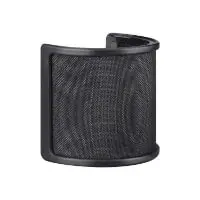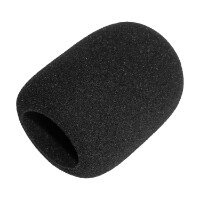How To Attach A Pop Filter To A Mic Stand
When I started podcasting, I was unhappy with my voice popping out in my episodes. To get rid of those pesky plosives from my podcast, I purchased a pop-filter, after scoring through all the reviews on the cyberspace. But the results didn't seem satisfactory. My vox was still popping out. And I was worried if my money had gone downwardly the drain. After discussing the situation with a podcaster friend, I realized that I had not set-upward my popular-filter in the right style.
Popular-filters do a smashing task of removing disturbances from the recording past acting as a filter betwixt your rima oris and the mic, provided you know how to set it upward. This is what I learned from trial and error, and I desire to share my findings with you and help you save your time.
How to Set up-Upwards a Pop-Filter For Recording a Podcast?
The best manner to set-up a popular filter is to maintain a distance of the size of your palm from the microphone. And while recording, the podcaster should be two-three inches abroad from the pop-filter. This placement brings out the best results from the recording procedure, and likewise makes the podcast sound natural.
A pop filter is a elementary tool that stops your vocalisation from splitting during the podcast recording, merely it's effective only when it's placed properly. New artists often make the fault of keeping the pop-filter too close to the microphone. Some of you might be new to the podcasting world, and clueless about how to set-up your popular-filter in the outset place. The set-up is a elementary procedure, let me break information technology down for you lot.
Setting Up Your Pop-Filter
- Start by adjusting the clamp to an open up position. For that, loosen the bolt of the pop filter.
- Place the pop filter close to the microphone, but there should exist no contact between the two. Decide where exactly on your microphone stand y'all desire to identify the popular filter. Now you lot have to adjust the gooseneck.
- Prepare an angle of two O'clock (or 10 O'Clock) between the pop-filter and the microphone. Information technology prevents the audio from bouncing off between the filter and the screen, and helps in reducing the plosive sounds.
- The pop-filter should never affect the microphone. However, the bodily distance that you want to keep betwixt the microphone and the pop filter depends on your personal preference. Maintain a altitude betwixt 2 to 6 inches to become rid of plosive sounds and sibilance, while getting the effects that you desire.

Is it Okay to Adapt the Pop-Filter While Recording?
While recording your podcast, make certain non to touch or movement the filter from its position. You should exist a few inches away from the popular-filter. The altitude between you and the mic has a great touch on on how your podcast recording would sound. Maintaining the same distance from the mic throughout the recording helps you achieve consistency in results, and a pop-filter, apart from performing its intended office, serves equally a reference for keeping that altitude.
For the same reason, I would advise you not to tamper or play around with your pop-filter in the center of the recording. If you are an apprentice, do a trial recording with your new pop-filter and equipment kickoff. Figure out the microphone meridian, microphone position, pop-filter placement, and the distance where you would stand up. When you are completely satisfied, practice the actual recording.
If you are used to gesticulating while recording, remind yourself to keep your hands off the filter. It would exist great if yous check the stability of your set-upward earlier recording. You wouldn't want the popular-filter to move from its position after the recording.
How to Keep The Popular-filter Make clean?
The pop-filter comes in shut proximity to your mouth and gets exposed to your saliva when you record. If you invite guests over for your recordings, it'southward trapping germs from them too. And then it's a good idea to clean the pop-filter one time in a week or two. You tin can simply clean your nylon or metal pop-filter with lather and water, and allow it dry for seventy-two hours.
Why Should Y'all Utilise a Pop Filter While Recording a Podcast?
A few people might wonder if they really need a popular-filter for recording a podcast. I would like to put their doubts to rest. If you inquire me, a pop-filter is a must for all vocalisation recordings, whether it'due south a podcast or vocal that's beingness recorded.
| | Double layer pop filter | Triple layer current of air filter | Cream filter |
| |  |  |  |
| universal size | universal size | always buy for specific mic | |
| check toll | cheque price | e.k. check price for Blue Yeti filter |
Pop-filter Eliminates Plosives
One of the chief reasons why podcasters utilise pop-filter while recording is to achieve a recording that is gratuitous from annoying plosives. If you are a newbie and wondering what's the whole fuss behind plosives, then hither is a quick caption for you. When an creative person pronounces certain heavy jiff consonants into a microphone, the high air pressure causes the voice to go windy or pop-out. The resulting sound is commonly goes past the name of plosives, and information technology can be easily filtered out by using a popular-filter. If you recall of information technology, that'southward why there are called 'pop-filters'!
Plosives are quite directional in nature and happen when you speak consonants like Ba or Pa directly into the microphone. When at that place is a popular-filter betwixt your mouth and the mic, the filter screen absorbs and scatters the sound before it reaches the mic. This machinery prevents plosive from getting recorded in your podcast.
Popular-filter Reduces Sibilance
Sibilance is the hissing audio that comes when a word or sentence contains a close repetition of 'ss' sounds. Sibilance as well happens with the audio 'sh' and 'z'. What makes sibilance painful to the ears is information technology's a loftier-frequency component. It is a natural aspect of human voice communication, but information technology gets magnified and sounds irritating on the recording.
Popular-filters exercise not eliminate sibilance but can help bring it down to some extent. This saves the time that would otherwise go into editing and removing the sibilance.
Like shooting fish in a barrel cleaning
The pop-filter too does a smashing job of saving your mic from the wet that would otherwise land on its surface from your mouth while you record. This is not just great for keeping things hygienic, but also adds years to the life of your microphone.
Things to look for while buying a pop filter
Gooseneck Quality
You wouldn't want to have a pop-filter that droops downwards while you are recording your podcast. It would be plain too abrasive to prepare it dorsum while focussing on your podcast script, and it might not be neat for your recording. Brand sure that the gooseneck is long, flexible, and stable so that y'all don't accept trouble placing it to the desired location, and it stays where y'all left it!
Size/ Diameter
The standard size for pop-filters is half dozen inches. The bigger your filter is, the more room you have to move effectually or express your trunk linguistic communication while recording your podcast. Remember that bigger pop-filters are heavier and they could pull downward your mic stand, so it's better to employ them with heavy and durable mics rather than smaller ones.
You can also opt for a smaller pop-filter that has a 4-inch bore. They are light-weight, which makes them suitable for carrying them to unlike locations. And they work quite well with smaller microphones or recording areas with limited spaces.
Mount
Well-nigh pop-filters come equipped with mechanisms to mount and clamp that is compatible with the commonly used microphone stands. If yous happen to utilize a desk-bound-mounted microphone, you demand to await for a popular-filter that you can prune to the mic directly, or to the desk.
Screen Cloth
Some screens are made of fabric (like nylon). Such filters are less expensive and work fine- they happen to be the common choice of vocalism artists and recording studios. Some artists detect the sound that's recorded through a nylon filter to exist quite vintage equally well. Simply nylon filters are tough to make clean, and they can get hands damaged.
There are other pop-filters made of woven or perforated mesh. They give an enhanced clarity in higher frequencies. This gives the recorded sound a modern edge. Metal pop-filters can exist easily cleaned, and they are quite durable. They are a bit more expensive, just their long lifespans make them worth every penny.
Both the kinds are used by professionals also as amateurs. And then make your pick based on the desired effect, and the coin you are willing to spend.
Do all microphones require a pop-filter?
All microphones require some grade of filter to aid y'all to get a better audio quality, but you don't need to add an externally mounted pop-filter to all mics.
Some mics sound peachy with a foam filter that comes with the mic itself, provided by the producer, e.g.:
- Shure SM7B (cheque current price), the best dynamic XLR recording mic, comes with a state of the art cream filter,
- Shure MV7 (check current price), the all-time USB mic, also comes with a fantastic foam filter.
Summary
If you want to astonish your listeners, you have to learn about the subtle nuances of vox recording. And setting up your equipment correctly is i such seemingly pocket-size thing that impacts your result. Regardless of the money that y'all take spent on the recording gear, you must understand its right installation to get a flawless recording.
1 such tiny detail that podcasters frequently overlook is the right set-up of their pop-filter. Don't allow your carelessness become the better of you. Learn the correct installation of pop-filter before you really start recording; information technology will really assistance bring finesse to your work.
Read next
How To Attach A Pop Filter To A Mic Stand,
Source: https://improvepodcast.com/how-to-set-up-a-pop-filter/
Posted by: fredericksbarpries.blogspot.com


0 Response to "How To Attach A Pop Filter To A Mic Stand"
Post a Comment